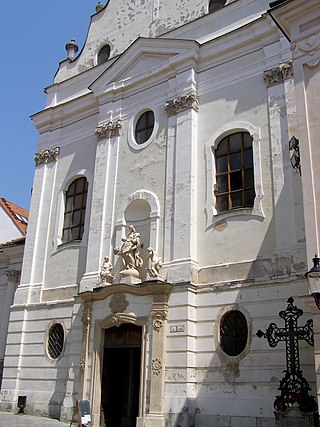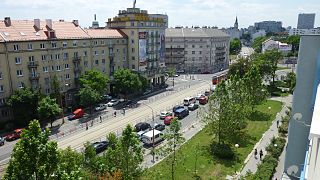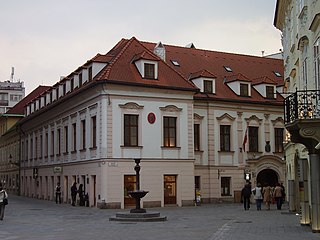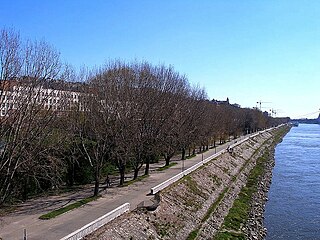Bratislava, currently the capital of Slovakia and the country's largest city, has existed for about a thousand years. Because of the city's strategic geographical location, it was an important European hub due to its proximity to the advanced cultures of the Mediterranean and the Orient as well as its link to the rest of Europe, which were possible by the Danube River.
Alojz Rigele was a Slovak sculptor and painter. He spent most of his life working in today's Bratislava, where numerous examples of his statues survive to this day. Rigele was considered to be among the leading sculptors in Slovakia before World War I. His specialty was sculpture, especially portrait.

The Episcopal Summer Palace is the former residence of the Archbishop of Esztergom.

The Old Town of Bratislava is the historic center and one of the boroughs of Bratislava, in the Bratislava Region of Slovakia. It is coextensive with the smallest Slovak administrative district by area, Bratislava I. It contains the small, but preserved medieval city center, Bratislava Castle and other important landmarks. Bratislava's Old Town is known for its many churches, the Bratislava Riverfront and cultural institutions, it is also the location of most of the foreign states embassies and important Slovak institutions including the National Council of the Slovak Republic; the Summer Archbishop's Palace, seat of the Government of Slovakia; and Grassalkovich Palace, seat of the President of Slovakia.

Bratislava I is a district in the city of Bratislava. It is identical with its sole borough, Bratislava's Old Town. With an area of 10 square kilometers, it is the smallest district of Slovakia. It is completely surrounded by other Bratislava districts: Bratislava II, Bratislava III, Bratislava IV and Bratislava V.

The Franciscan Church is the oldest existing religious (sacral) building in the Old Town of Bratislava, the capital of Slovakia. The church was consecrated in the year 1297 in the presence of King Andrew III of Hungary. In the past, the church building served for larger gatherings of townspeople or Hungarian nobles. In 1526 Ferdinand I, Holy Roman Emperor was elected here to become the King of Hungary. During coronations, kings used to knight nobles as Knights of the Order of the Golden Spur in this church.

Račianske mýto is a major transport junction and intersection in Bratislava, the capital of Slovakia. It connects the city center with the suburb of Rača and also serves as a transport artery between Trnavské mýto and Old Town.

Bratislava is the capital city and the cultural and economic centre of Slovakia. It is home to several museums and galleries, including the Slovak National Museum and the Slovak National Gallery.

Bratislava fortifications usually refers to the medieval city fortifications of Bratislava, the capital of Slovakia, of which one gate and two sections of walls remain today. The Bratislava Castle was also heavily fortified. Other fortification systems were built in the following centuries, including a World War I artillery fortification system and World War I shelters, system of bunkers and fortifications built by the First Czechoslovak Republic between the World Wars, World War II aircraft raid shelters, fortifications built by the Nazi Germany in the city during World War II and finally Cold War-era city defenses including a system of 8,602 air raid and nuclear shelters capable of holding over 760,000 citizens, far more than the number of inhabitants. The pinnacle of the communist era city defense was a military rocket base located on the Devínska Kobyla hill, the highest point in the city.

Bratislava, historically known as Pozsony and Pressburg, is the capital and largest city of the Slovak Republic and the fourth largest of all cities on the River Danube. Officially, the population of the city is about 475,000; however, some sources estimate daily number of people moving around the city based on mobile phone SIM cards is more than 570,000. Bratislava is in southwestern Slovakia at the foot of the Little Carpathians, occupying both banks of the River Danube and the left bank of the River Morava. Bordering Austria and Hungary, it is the only national capital to border two sovereign states.

Zochova Street is a street in Bratislava's Old Town and Zochova is the name of a major bus stop in Bratislava, located at the point where the street touches Staromestská Street, next to Nový Most in Bratislava, Slovakia. the lower half of the street formed part of the Old Town of medieval Pressburg, with the first written account confirming its existence dating from the 14th century. Zochova Street is located just 5 minutes walking distance from the historical city center and 5 minutes walking distance from the Presidential palace at Hodžovo námestie.

Palisády Street is a major street in Bratislava's Old Town connecting Hodžovo námestie and Bratislava Castle in the Slovakia's capital. The street is served by public transport trolleybusses. Near the Bratislava Castle and National Council of the Slovak Republic building it bends sharply and continues as Mudroňova Street, together forming the main passageway through the western part of the Bratislava Old Town.

Pálffy Palace is a 17th-century palace of the Pálffy family on Zámocká Street in the Old Town of Bratislava, Slovakia, situated underneath the Bratislava Castle. After partial demolition at the beginning of the 20th century, only the summer pavilion of the original palace complex remains and today, the building is a protected cultural monument and is used for cultural events. Wolfgang Amadeus Mozart performed a concert in the palace during his visit of Bratislava.

Keglevich Palace is a Baroque mansion on Panska Street 27 in Bratislava, Slovakia. It is included among the National Monuments Reservation of the city and is also listed as a Cultural Real-estate Monument. The last reconstruction was in 1998, involving the roof and facade rendering. Following the reconstruction a new street was named Strakova Street. It is between Venturian Street and Hviezdoslavovo námestie (Bratislava).

Bratislava Riverfront is a riverfront on the river Danube located on the Old Town side of Bratislava, Slovakia. It extends from the Karloveská bay near the Lafranconi Bridge to the Port of Bratislava and Harbour Bridge. In the past, the riverfront included the Coronation Hill, where the newly crowned Kings of Hungary would recite an oath and make crosses with their sword in four cardinal directions to show their resolution to defend the country. The hill was demolished in 1870 when the shores of the Danube were strengthened.

Košice Staré Mesto is a borough of Košice, Slovakia. It encompasses the historical centre of the city, consisting of the medieval and early modern core of Košice, with many preserved historical buildings of several architectural styles, and a small number of more modern architecture. The borough also includes the immediate environs of the historical centre.

Medical Garden is a public park in Bratislava, Slovakia. It is located in the Old Town near the American square and behind the Aspremont Summer Palace.
Johann Nepomuk Gobert d'Aspremont-Lynden was an Austrian nobleman from the House of Aspremont-Lynden and Count of Reckheim. The Aspremont Summer Palace in Bratislava is named after him.





































